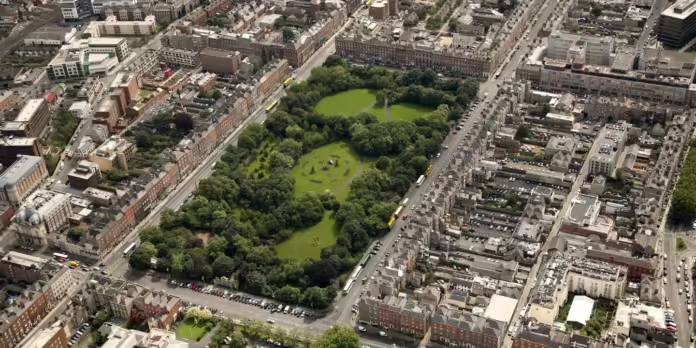Merrion Square, situated in the heart of Dublin, stands as one of the city’s most nptable Georgian squares. Laid out in the mid-18th century, it is a testament to Dublin’s rich architectural and cultural heritage. Encircled by grand Georgian townhouses, the square’s elegant design and well-preserved buildings showcase the meticulous urban planning characteristic of the period.
The square is positioned to the south of the River Liffey, and sits between the bustling streets of the city center and the Grand Canal. This prime location has cemented Merrion Square as a central landmark within Dublin’s urban landscape. The square is a verdant oasis that provides a tranquil retreat from the city’s hustle and bustle. Mature trees, meticulously maintained lawns, and vibrant flower beds contribute to the park’s picturesque scenery, making it a favorite spot for both locals and tourists.
Surrounding the park, the Georgian townhouses add to the square’s charm and historical significance. These stately buildings, with their red-brick facades and ornate doorways, exemplify the Georgian architectural style that flourished in Dublin during the 18th and early 19th centuries. Many of these houses have been meticulously restored and repurposed, now serving as offices, cultural institutions, and private residences. Notably, several prominent figures have called Merrion Square home, further enriching its historical narrative.
Merrion Square’s significance extends beyond its architectural beauty. It has long been a hub of cultural and social activity, hosting various events and festivals throughout the year. The square’s central location and historical allure make it an essential starting point for anyone looking to explore Dublin’s rich heritage.
Historical Background
Merrion Squares past dates back to the 18th century. Established in 1762, the square was part of a grand vision to expand Dublin’s urban landscape. The development was spearheaded by several notable architects, including John Ensor and Samuel Sproule, who played pivotal roles in shaping its architectural identity. The square quickly became a prestigious address, attracting an array of influential residents.
Among the most famous occupants were literary giants Oscar Wilde and W.B. Yeats. Wilde, known for his sharp wit and flamboyant style, resided at No. 1 Merrion Square, a Georgian townhouse that remains a point of interest for literary enthusiasts. W.B. Yeats, a key figure in the Irish Literary Revival, also called Merrion Square home. Their association with the square adds a layer of cultural significance, highlighting its role as a hub for intellectual and artistic endeavors.
The architectural style of Merrion Square is quintessentially Georgian, characterized by its symmetry, classical proportions, and decorative elements. The townhouses, with their red brick facades, elegant doorways, and sash windows, exemplify the design principles of the era. These features also signify the social status of their inhabitants. The uniformity of the buildings contributes to the square’s tidy and neat charm.
Over the years, Merrion Square has managed to retain much of its historical essence, even as it has adapted to the modern-day ongoing development of Dublin. The square has been meticulously preserved, with many of its original features intact. Today, it serves as a vibrant public space, hosting events, exhibitions, and cultural activities.
Interesting Stories and Anecdotes
Merrion Square is teeming with captivating stories that breathe life into its illustrious past. As mentioned a key figure whose legacy is deeply intertwined with the square is the illustrious Oscar Wilde. His early years were shaped by the cultural vibrancy of Merrion Square. A stroll through the square today reveals a striking statue of Wilde, reclining in a state of eternal contemplation, a tribute to his genius and enduring influence.
Beyond Wilde, Merrion Square has hosted an array of notable residents who have left an indelible mark on its history. Sir William Wilde, Oscar’s father, was a renowned surgeon and author, contributing to the intellectual milieu of the area. Another very prominent figure, Daniel O’Connell, known as “The Liberator” for his efforts in Catholic emancipation, resided at No. 58. His presence underscores the square’s role as a hub for political and social discourse.
The square’s history is punctuated by fascinating events and cultural happenings. During the 19th century, it was a focal point for various public demonstrations and gatherings, reflecting the city’s evolving political landscape. The annual Merrion Square Open Day transforms the area into a vibrant festival, celebrating its artistic and historical heritage with exhibitions, performances, and guided tours.
Quirky tales also add a unique flavor to Merrion Square’s narrative. One such anecdote involves the mysterious “Dublin Bay Mermaid” sculpture that appeared overnight in 2012, capturing the imagination of locals and visitors alike. This whimsical addition sparked widespread curiosity and became an instant talking point.
Trivia enthusiasts might be intrigued to learn that the square’s design includes one of Dublin’s few remaining public gas lamps, harking back to an era when the city was illuminated by their soft glow. These stories and snippets of history contribute to the rich, multifaceted character of Merrion Square.
Merrion Square Today
Merrion Square stands as a vibrant cultural hub in the heart of Dublin, seamlessly blending historical significance with contemporary relevance. The Georgian architecture that once housed Dublin’s elite now serves diverse modern purposes. Many of these well-preserved buildings have been converted into museums, embassies, and offices, each contributing to the square’s dynamic atmosphere. Notably, the Irish Architectural Archive and the National Gallery of Ireland are located here, providing rich cultural experiences for visitors and locals alike.
The central park, a lush green space within Merrion Square, is a focal point for community activities and events. Throughout the year, it hosts a variety of outdoor festivals, art installations, and guided tours that captivate both tourists and residents. The park’s serene environment is perfect for leisurely strolls, picnics, and even impromptu performances, making it a beloved retreat in the bustling city.
Art enthusiasts will find Merrion Square particularly appealing due to its vibrant artistic scene. The square frequently features outdoor exhibitions and sculptures, reflecting Dublin’s rich artistic heritage. Additionally, guided tours offer insights into the square’s historical and architectural significance, enhancing the visitor experience. These tours often highlight the notable personalities who once resided here, weaving fascinating stories into the fabric of Merrion Square’s modern identity.
Merrion Square’s ability to balance historical preservation with contemporary use is a testament to its enduring appeal. The square not only honors its past but also adapts to the needs of the present, making it a must-visit destination for anyone exploring Dublin. Whether you’re interested in history, culture, or simply enjoying a beautiful day outdoors, Merrion Square offers a unique and enriching experience that captures the essence of Dublin’s charm and vitality.


